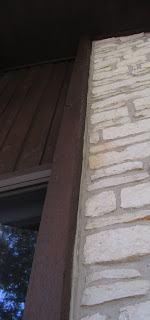When the painters were here, they pointed out that there were cracks in the extrior walls, mainly where the stone meets the trim.
For example, the window in the library out to the front porch, on the exterior, has these two huge beams vertically on each side of the window. There is a large gap between the beam and the stone work.
And there were other, minor, places where there were holes, along the fascia boards where they meet the stone.
For this long gap in the front, the main painter supervisor suggested a caulk that is colored to look like mortar. Loctite PL Concrete ($10.80 at Home Depot).
That seems to work pretty well, although you do have to be very careful of where it goes -- it does not clean off well.I used just mortar (and water) on a couple of other places.
Update: 17 July 2025
I also noticed that there were left-over holes that had been drilled in the stone, but were no longer being used. For example, there were 4 holes that had been drilled near the North West faucet, to hold a hose reel, but it must have broken, and been removed, leaving nothing but the holes.
We could try filling them with mortar, but mortar is grey and the limestone stones are more white. So I went looking for an outdoor permanent caulk to fill the holes, that would match (mostly) the color of the stone. I found Vulkem 116 Exterior Polyurethane Sealant which comes in 16 different colors. Comparing the color samples on the website to a photo of the wall, it looks like "Stone" is the closest match. And the hardest to purchase. But I found it available at Metro Sealant, for only $6.99 (plus $1.68 CA sales tax). And $13.38 for shipping.
But it does a passable job.
There were also holes like this at all the other faucets, and also in the area where the solar system inverter and such was removed for the first solar system.
Some of the holes went into the mortar between the limestone stones. In that case, I just filled it in with mortar.
Update: 22 July 2025
In the front of the house, there is a pillar with a large crack in the mortar.
We used another tube of the Loctite PL Concrete to fill it in.
That seems to have worked okay. Of course, you can't get up close to see it without a really long ladder (16 feet).
Update: 26 July 2025
We had a wasp problem in two corners of the house. The wasps were going behind the fascia boards at the North and South corners on the West side of the house. We discovered this when we were starting to paint the house, as far back as June 2025. But we worked around it by spraying with a Wasp and Hornet spray. That would kill one or two (out of the 6 or 7) wasps hanging around, and scatter the others, at least for a little while. Within a day, or maybe only hours, they returned. We used 5 cans of the Wasp and Hornet spray, and we still have a problem.
It seemed they must have a nest inside the walls, and were just going to and from it via the joint between the stone facade and the wood fascia board. So the theory was that sealing the joint would prevent them from entering and solve the problem.
We first used a can of the Great Stuff foaming sealer. That did a good job of sealing almost everything, but the wasps hunted around and found small holes that were not completely sealed and contined to go in and out. So we turned to the Loctite PL Cement caulk and used it, over the spray foam, to seal the remaining areas, both the South West corner
and the North West corner.
We worked at night (the wasps seemed to not be present at night), and the North West corner could have been done more carefully to avoid getting it on the trim.
While this seems to have stopped the wasps from going into the space behind the stone facade, they are still hanging around both corners, presumably confused by the disappearance of their entry ways, but not having anywhere else to go. We assume that over time the problem will go away.










No comments:
Post a Comment